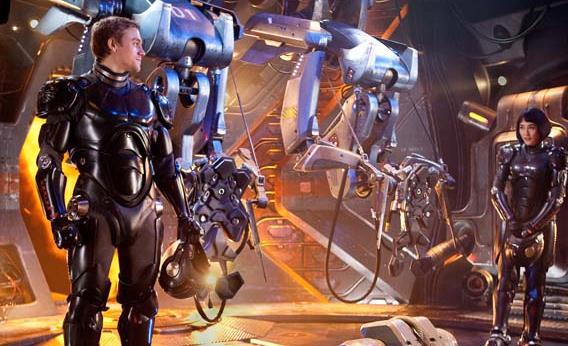Most of us are used to Hollywood’s depiction of robots as threats to the human race. Stories such as Terminator, Blade Runner, Battlestar Galactica, and countless others are dominated by the “Frankenstein Complex,” described by Isaac Asimov as the fear that man will lose control over his technological creations. Pacific Rim, however, represents a departure from this notion, as it features giant robots (Jaegers) that hold the key to defeating sea monsters that threaten humanity.
Fans of Japanese science fiction and anime will recognize the Jaegers as “mecha,” a designation applicable to any machine, but refers primarily to armored, often giant, fighting robots. In mecha anime, humans usually control these robots, much as in Pacific Rim, where two human pilots control each Jaeger. The difference between conventional Japanese and Hollywood portrayals of robots reflects disparate cultural mentalities about technology, particularly robots, and about the value of individuality.
Asimov argued that the real root of humans’ fear is “not that machinery will harm us—but that it will supplant us. It is not that it will render us ineffective—but that it will make us obsolete.” While our fiction depicts fear of a robo-paclypse, our nonfiction focuses on this fear of supplantation. Every day, the news shows us something else robots can (or are at least on the road to) do better than humans: They’re cooks, waiters, factory workers, pharmacists, drivers, surgeons, and soldiers, to name a few. Headlines warn us of the myriad human jobs being lost to robots.
Asimov is on to something when he argues that we’re more scared of supplantation than death. Being replaced by robots undercuts our belief in our own exceptionalism. We don’t want to believe that another race of beings could replace us, and we don’t want to think that any single robot could replace any individual.
Human-piloted mecha, however, neither escape human control nor replace humans. Instead of being the enemy, they’re teammates; alone, neither humans nor robots can get the job done. Pacific Rim is particularly unusual for Hollywood because it downplays individuality. First, two human pilots meld minds, and then the human team controls the giant robot, suggesting that the Jaeger is greater than the sum of its parts.
Where Americans tend to see robots as competition, the Japanese see them as companions, largely because they’ve been conditioned by mecha. A 1956 Japanese manga, Tetsujin 28-go (Iron Man No. 28), featured the first humanoid mecha driven via remote control by a boy named Shotaro Kaneda. In 1972, Mazinger Z featured mechas controlled from a cockpit, much like those located in the Jaegers’ helmets.
In Japanese stories, mechas become an extension of, not a replacement for, humans. This partially accounts for the emotional connection humans have to their mecha. We become attached to cars or to any mechanism that gives us increased power. But Shotaro, for example, is deeply attached to Tetsujin 28 because the robot was created by his father shortly before his death. Tetsujin can’t replace Shotaro’s father, but the mecha symbolizes him and becomes a vessel for Shotaro’s love.
The idea that humans can genuinely care for robots also manifests in Japanese robot technology. Japanese engineers actively try to make robots more human. Right now, Japan uses 250,000 industrial robots, as well as robot teachers, guards, house-sitting robots, robots that move more like humans, imitative, humanoid robots for use in hospitals, social robots both humanoid and not, and wedding officiates. And that’s just for starters.
The idea that robots are companions rather than competitors makes the Japanese less susceptible to the “Uncanny Valley” theory (which posits that when robots are too human they become repulsive), and to the fear of replacement. The Japanese seem to believe that a society with robots will be more productive, efficient, and happier than one without them. The teamwork concept illustrated by human-piloted mecha applies here: if society is the team, then having good players increases the chances of society “winning.” The human-mecha team is a symbol of the mutually beneficial coexistence that results from integrating robots into society. Thus, no paradigm shift is necessary for people to accept robots socially or emotionally.
The 2009 Nintendo DS game Love Plus spawned one Japanese man’s marriage to one of the characters. A Global Mail article describes a Japanese engineer’s love for his “droid girlfriend” and his expectation of “a lifelong commitment.” One of men interviewed in the Global Mail article says, “Everything is equal. We have no borders between robots and people.” The belief that robots enhance humanity contributes to the lack of boundaries, as does the pervasive Japanese belief that robots have souls. Many people in Japan believe that tamashii, or spirits, can be found in anything from anime characters to robots to rocks. Thus, humans aren’t unique, superior, or irreplaceable for having souls, and the acceptance of robots doesn’t mean integrating soulless hunks of metal into society.
Asimov predicted that someday, humans would wonder how they ever survived without robots. The Japanese may be the first to prove him right. Japanese engineers have developed a real mecha that fires plastic bbs when the pilot makes it smile. Maybe it will come in handy when the sea creatures rise.
